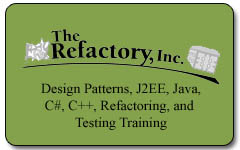Hello! Since this is my first post, let me introduce myself. My name is Reza Razavi. I’m currently heading the research and innovation efforts of AAS that I co-founded in 2007. I’ve been involved in developing industrial AOMs since 1993. In particular, I implemented a software system for calibrating bore gauges that allows domain experts defining new gage types, their attributes and calibration procedure themselves, and make them readily (without compilation) available for use by calibration operators. Calibration procedures are defined as a composition of atomic measurement and calculation services. This allowed our customer to reduce the cost of their maintenance by at least a factor of ten, while being able to easily adapt their gauge calibration procedures to specific customer needs. Then, I switched to academic research and have been collaborating with Ralph Johnson and Joe Yoder since the early days they initiated research on AOMs.
Now, as an early adopter of AOMs for both industrial and academic software projects, I would like to react to the Rebecca’s tweet/retort to Michael Feathers (@mfeathers) where she stresses “Meta-architectures aren’t “old” technology…they’re “proven” technology…”.
For example, here at AAS we have developed a novel software platform that allows developing web-enabled AOMs by reuse and extension. We are currently working on large scale development of such AOMs to address the need for individualized and adaptive web-based solutions to populations like the elderly. The elderly need customized care. Imagine that each person had a computer in the cloud that watched over him or her. We propose adaptive web servers to empower end-users and their communities, like caregivers, to give themselves an active part in the design and customization of their web-based services. So, once more, meta-architectures and AOMs have proven powerful in supporting business applications with highly-demanding dynamic adaptivity requirements.
It should also be emphasized that with AAS-Platform, AOMs figure today at the very heart of a unique solution to the latest approaches to service delivery and business development as explained in The Power of Pull , where end-users and their communities are perceived themselves as valuable actors of service innovation and personalization, and empowered to assume their responsibilities.
Furthermore, as it is emphasized by David Siegel in his Open Letters to Apple Board Members, and Sergey Brin, Larry Page, and Eric Schmidt (Google), “the future of media, entertainment, productivity, and business tools is in the cloud”. However, “the power shift of the 21st century is not to use the cloud to re-create our desktop tools but to build data-driven ecosystems that take us far beyond what we could have done without the power of the cloud.”. David Siegel, urges that to build “data-driven ecosystems”, and to “empower people to collect and use their own data for themselves” (in alignment with the “pull” model), web technologies shall start by “getting the data out of the apps”.
AAS-Platform has been designed and implemented with these requirements and service delivery model as primary considerations. It enables the large-scale development of websites like Yahoo! Pipes by regular application developers, where the active and collaborative participation of end-users (even non-technical people) as partners in the service innovation and delivery processes is supported by design.
Specifically, AAS-Platform allows Web-based AOMs that maintain an “open user activity flow model”, and allow end-users to interact with and modify that model (which is otherwise “hard-coded” by programmers). Every piece of meta-data and data that end-users care about may be accessed via dedicated atomic services and reused when assembling new services, thereby contributing to the concept of “data-driven ecosystems”. Read more …
